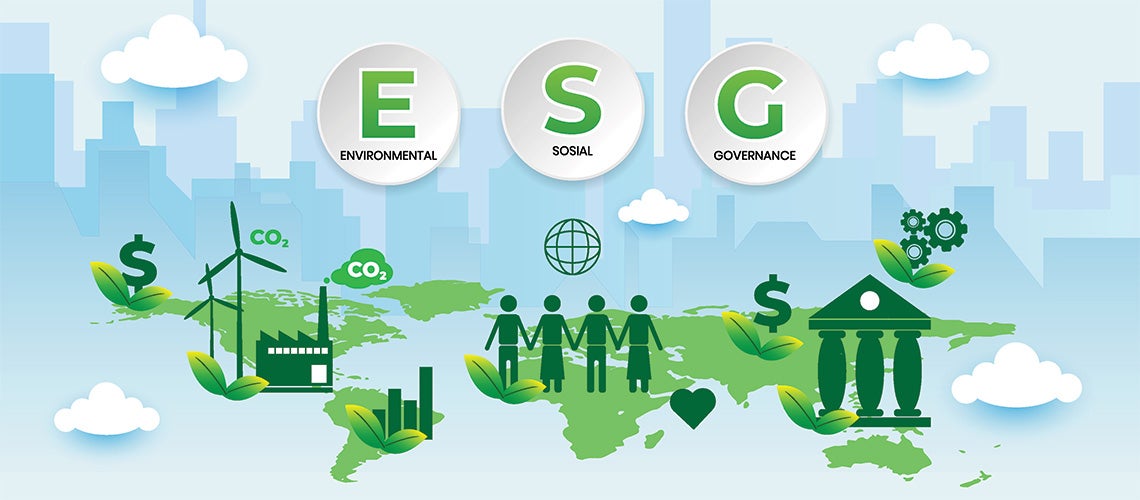 ESG concept of environmental, social and governance in sustainable business | © shutterstock.com
ESG concept of environmental, social and governance in sustainable business | © shutterstock.com
Central bank reserve managers are seeking ways to incorporate environmental, social, and governance (ESG) factors into their fixed-income investments.
Central bank reserves have collectively grown to over $14 trillion, yet only one in six central banks considers social, governance, and environmental (ESG) factors in their investments. Our team set out to answer why reserve managers incorporate ESG into their portfolios. We published our findings in a primer on ESG for reserve managers to respond to central banks' growing demand for knowledge on ESG in their investments. The practice of incorporating ESG factors into investment decisions has developed over the past 60 years for equity investors, but only recently has it gained ground among fixed-income investors.
Challenges to Implementing an ESG Strategy
Implementing ESG in investment approaches presents four main challenges. First, a uniform definition of ESG is still lacking, and investors consider many factors under the broad term ESG. Second, investors lack consistent accounting frameworks and disclosures, constraining their ability to compare and assess investments across all areas of ESG. Third, empirical research on the impact of applying ESG on financial returns is still inconclusive, especially in the fixed-income space. Fourth, measuring whether impact investment achieves its desired effects is difficult.
However, the most important constraint for fixed-income investors is the size of the thematic or labeled bond market, which finances entities and projects with ESG objectives. This market is very small, concentrates on few issuers, and has lower liquidity than the market for conventional bonds. The market represents about 3.5 percent of total global bond issuance. The investable universe is $621 billion, representing a small fraction (i.e., 0.5 percent) of the global bond market.
Central banks use conservative investment guidelines, which narrows the availability of possible ESG investments. These institutions typically invest in sovereign, supranational, and agency issuers with high credit ratings, further reducing the set of eligible thematic bonds. Central banks would have to consider alternative investments with higher risk, such as corporate bonds, and for many banks this is not a viable solution.
Central banks need to ensure that their approach to ESG is consistent with the existing reserve management framework and the traditional investment objectives of safety, liquidity, and return. Incorporating ESG considerations into reserve management can be consistent with traditional investment objectives if, for example, ESG analysis could improve risk management and support the safety objective. We found that regardless of whether sustainability becomes a fourth objective, including ESG considerations in the investment policy is the most effective way to institutionalize this practice. The participation of central bank boards in this decision is critical, as it can guide management and staff throughout the implementation phase of the ESG approach.
An ESG policy is not convenient for all central banks, however. Some of the factors that may hinder an ESG policy include regulatory obstacles (e.g., narrow interpretation of fiduciary duty), low buy-in from critical stakeholders (e.g., politicians), lack of portfolio diversification, and weak institutional capacity.
Central banks consider ESG not only for financial reasons, but also to manage reputational risk and set a good example (figure 1). Pressure from the public or peer institutions is not a significant motivation for central banks to consider ESG.
Figure 1. Motivations of Central Banks That Consider ESG

ESG implementation in reserve management is gradually gaining ground. As figure 2 indicates, nearly one in six central banks have included ESG in their investment policies. In addition, one in 10 have considered ESG factors in their investment management framework. Nonetheless, the majority of institutions have not used ESG factors in the investment process. Nearly one-third of central banks reported having discussions but no implementation, while almost half had neither.
Figure 2. Central Banks That Incorporate ESG Factors in Their Investment Process

Five Approaches to Implementing an ESG Strategy
For the central banks that take the step into ESG investing, we lay out five traditional methods for integrating ESG factors into the investment process and analyze the scope for applying them in foreign reserve portfolios (table 1). We find that incorporating financially material ESG factors into investment risk analysis and investing opportunistically in thematic bonds is the best approach. However, the approach depends on the asset class, and more diversification across asset classes improves the opportunities to apply ESG approaches. Since high-quality, fixed-income securities are the most significant asset classes in reserve portfolios, impact investing may offer an opportunity for central banks interested in adopting ESG. However, that approach, which several central banks already follow, faces the challenges of still tiny market capitalization and low turnover of thematic bonds.
Table 1. ESG Approaches to Reserve Management

Additionally, central banks can start following standard market practices, like monitoring ESG scores and building impact reports, because ESG scores can strengthen their risk management framework. The scores assess their level of ESG implementation, both in absolute terms and relative to the benchmark. Finally, building impact reports can improve understanding of ESG investing for internal and external stakeholders.




Join the Conversation